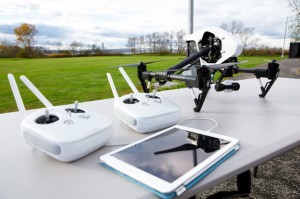 In a step to cement its dominance as the market leader in the “prosumer” drone photography sector, DJI released its latest model last week, the $2,900-priced Inspire 1. The Hong Kong-based UAV manufacturer had already flown into the industry stratosphere with its earlier release of the Phantom – the darling of the drone videographer community.
In a step to cement its dominance as the market leader in the “prosumer” drone photography sector, DJI released its latest model last week, the $2,900-priced Inspire 1. The Hong Kong-based UAV manufacturer had already flown into the industry stratosphere with its earlier release of the Phantom – the darling of the drone videographer community.
With the release of the Inspire, DJI breaks into the 4K video realm, offering photographers the opportunity to capture crisp video with a flexibility of angles using the Inspire 1’s robotic ‘arm’ capable of turning the cam 360 degrees around and 125 degrees down. Recognizing that flying a drone whilst capturing footage can be a two-person task, DJI designed the Inspire with the flexibility of operating from one or two remotes for a pilot and/or photographer.
The real cool factor, though, has to be in the legs. As the drone takes off, its legs fold inward (which, at least for this geek, evoked images of the Imperial spy droid from Empire Strikes Back; laser blaster optional). For the advanced photog, the Inspire uses the company’s Lightbridge system which can display and store video up to 1080 resolution in real time on to an extended remote display (think of an iPad married to an xBox controller) up to a distance of more than 1 mile.
[cms id=”7820″]
For indoor flight, DJI’s new Optical Flow technology uses a specially designed camera as well as sonic waves that allows the Inspire to hold its position indoors, stop when the controls are released, and respond to commands even when GPS is unavailable.
The Inspire is compatible with a comprehensive (free) mobile app encompassing manual camera controls, flight telemetry and auto takeoff and landing.
What the experts are saying:
“DJI has packed just about every feature a videographer — or photographer — could want into the Inspire 1.” – David Cardinal, ExtremeTech
“At $2,800, the Inspire 1 isn’t cheap, but it packs an unparalleled suite of technology in its arsenal.” – Matt Burns, TechCrunch
“The drone game has changed. That may sound like hyperbole, but that was my first impression when experiencing the DJI Inspire 1.” – Ben Popper, The Verge
The Specs
- Weight (Battery Included) – 2935 g
- Hovering Accuracy (GPS mode), Vertical: 0.5 m, Horizontal: 2.5 m
- Max Angular Velocity: Pitch: 300°/s, Yaw: 150°/s
- Max Tilt Angle: 35°
- Max Ascent Speed: 5 m/s
- Max Descent Speed: 4 m/s
- Max Speed: 22 m/s (ATTI mode, no wind)
- Max Flight Altitude: 4500 m
- Max Wind Speed Resistance: 10 m/s
- Max Flight Time: Approximately 18 minutes
- Indoor Hovering: Enabled by default
- Camera: X3, Model FC350
- Resolution: 12.0 MP
- FOV (Field of View): 94°
- CMOS: Sony EXMOR 1/2.3”
- Lens: f/2.8 (20 mm equivalent) 9 Elements in 9 groups, Aspherical lens element, Anti-distortion filter, UV filter
- Still Photography Modes: Single shoot, Burst shooting (BURST: 3/5/7 frames,AEB: 3 or 5 bracketed frames at 0.7EV Bias), Time lapse
- HD Video Recording Modes: UHD (4K): 4096x2160p24/25,3840x2160p24/25/30
- FHD: 1920x1080p24/25/30/48/50/60
- HD: 1280x720p24/25/30/48/50/60
- Max Bitrate of Video Storage: 60 Mbps
- Supported File Formats: FAT32/exFAT
- Photo: JPEG,DNG
- Video: MP4/MOV (MPEG-4 AVC/H.264)
- Supported SD Card Types
- SD/SDHC/SDXC Micro SD
- Max capacity: 64 GB. Speed: Class 10 or higher
- Battery: 6000 mAh LiPo 2S
Jason is a longstanding contributor to DroneLife with an avid interest in all things tech. He focuses on anti-drone technologies and the public safety sector; police, fire, and search and rescue.
Beginning his career as a journalist in 1996, Jason has since written and edited thousands of engaging news articles, blog posts, press releases and online content.
Email Jason
TWITTER:@JasonPReagan
Subscribe to DroneLife here.







Leave a Reply